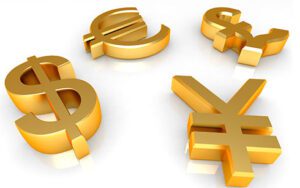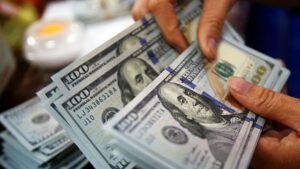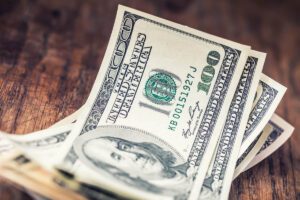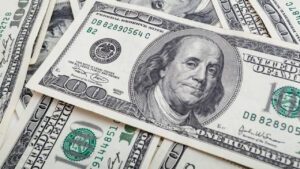
The US dollar is getting cheaper against the euro, the yen and the pound sterling in trading on Tuesday after the previous session’s strengthening following another Federal Reserve (Fed) statement.
This week, traders will focus on the Federal Reserve’s minutes of November 1-2 meeting at which the U.S. central bank raised its benchmark interest rate by 75 basis points (bps) and hinted at a possible slowdown in the rate hike.
The minutes of the meeting will be released Wednesday at 9 p.m. ET.
On Monday, Federal Reserve Bank (FRB) presidents Loretta Mester and Mary Daly of Cleveland and San Francisco signaled that the U.S. central bank would slow the pace of prime rate hikes next month, while stressing that the need for further policy tightening remains.
“I believe we can slow down the rate hike at the next meeting, I don’t see a problem with that,” Mester told CNBC. – However, I don’t think we’re close to pausing.”
For her part, Daley said the Fed should be mindful of the time lag between Fed decisions and their impact on the real economy. At the same time, she reiterated that she sees the need to raise the rate to at least 5%.
The ICE-calculated index showing the dollar’s performance against six currencies (euro, Swiss franc, yen, Canadian dollar, pound sterling and Swedish krona) lost 0.18% on Tuesday, while the broader WSJ Dollar lost 0.17%.
The euro/dollar pair is trading at $1.0259 as of 8:15 a.m., up from $1.0243 at the close of the previous session.
The dollar traded down to 141.78 yen from 142.14 yen on Monday.
The pound rate rose to $1.1851 compared to $1.1824 the day before.

The dollar is rising strongly against the euro and the pound sterling and moderately more expensive against the yen, thanks to increased demand for protective assets and hawkish statements from Fed chiefs.
The ICE-calculated index showing the dynamics of the US dollar against six currencies (euro, Swiss franc, yen, Canadian dollar, pound sterling and Swedish krona) is up 0.4%, while the broader WSJ Dollar Index is up 0.34%.
The euro/dollar pair is trading at $1.0284 by 7:35 a.m., versus $1.0326 at the close of last Friday’s session; the euro is losing about 0.4%.
The dollar/yen is up 0.1% at 140.47 yen, up from 140.39 yen at the end of last session.
The pound is getting cheaper by 0.5% and is trading at $1.1829 versus $1.1888 the day before.
Federal Reserve Bank of St. Louis Governor James Ballard said last week that the Fed would have to keep raising the benchmark interest rate. At the same time, the charts accompanying his remarks showed that its level could reach 5-7% per year.
Meanwhile, Boston Fed Chair Susan Collins said Friday that the Fed could consider various options for changing the interest rate at its December meeting, including a 75 basis point hike.
The Fed has raised the rate by 75 bps at its last four meetings, and now analysts and economists generally expect the next hike to be 50 bps.
The Fed will hold its next meeting on December 13-14.
The dollar is also supported by demand for safe haven assets amid fears over the spread of the coronavirus in China and actions by authorities to contain the pandemic, writes Trading Economics.

The dollar rises moderately against the euro and the pound sterling, but weakly depreciates against the yen as market participants assess statements by members of the U.S. Federal Reserve (Fed).
The ICE-calculated index showing the U.S. dollar against six currencies (euro, Swiss franc, yen, Canadian dollar, pound sterling and the Swedish krona) is up 0.16%, while the broader WSJ Dollar Index is up 0.14%.
The Fed will raise the benchmark interest rate by at least another 1 percentage point or more, and only after that could it take a pause, Mary Daley, head of the Federal Reserve Bank (FRB) of San Francisco, said the night before. A rate range of 4.75-5.25 percent “is a reasonable level to consider,” she told CNBC.
Kansas City Fed Governor Esther George also said the Fed should not stop raising rates too soon, and added that the goal of achieving a “soft landing” could be difficult.
The Fed has raised the benchmark interest rate by 3.75 percentage points (pp) in less than a year, increasing it by 0.75 pp at once in the last four meetings. The rate is currently at 3.75-4% per annum, and the market expects it to rise by 50 bps in December.
By 8:52 Moscow time the euro/dollar pair is trading at $1.0378 versus $1.0396 at the close of Wednesday’s session and the euro is losing about 0.2%.
The dollar/yen exchange rate is down 0.1% at 139.39 yen, down from 139.54 yen at the end of last session.
The pound is getting cheaper by 0.2% and trades at $1.1895 against $1.1915 the day before.
On Thursday the market is waiting for the final data on October inflation in the euro area and data on the construction of new houses in the USA.

The dollar is moderately depreciating against the euro and appreciating against the yen on Wednesday morning as investors assess geopolitical risks and U.S. inflation data.
The ICE-calculated index, which shows the U.S. dollar’s performance against six currencies (euro, Swiss franc, yen, Canadian dollar, pound sterling and Swedish krona), is up less than 0.1%, as is the broader WSJ Dollar Index.
The day before, the dollar index had fallen to a three-month low on further signals of slowing U.S. inflation.
As it became known on Tuesday, producer prices in the United States (PPI) rose 8 percent year-over-year in October and 0.2 percent against September. Analysts polled by Trading Economics forecasted an average increase of 8.3% for the former index and 0.4% for the latter.
Meanwhile, Rafael Bostic, head of the Federal Reserve Bank (FRB) in Atlanta, expressed the view that the Fed should continue to raise interest rates until there are signs of widespread easing in inflation. “We haven’t seen that yet, so I believe we will need new rate hikes,” Bostick wrote. He added, however, that he sees “glimmers of hope” in the past three months, but prices are falling mostly for goods, not services.
The currency market is also reacting to news of a rocket explosion in Poland, which killed two people. A number of media outlets wrote that the missile could have come from Russian territory.
However, Polish President Andrzej Duda said the government could not yet confirm who fired the missile, and U.S. President Joe Biden said it was unlikely that it came from Russian territory.
The Russian Defense Ministry denied that the rockets were Russian, saying that the military had not struck any targets near the Ukrainian-Polish border.
The euro/dollar pair was trading at $1.0370 by 7:52 a.m., versus $1.0350 at the close of Tuesday’s session, with the euro strengthening 0.2%.
The dollar/yen is up 0.4% at 139.82 yen, up from 139.31 yen at the end of last session.
The pound is stable and trading at $1.1865.

The US dollar is getting cheaper against the euro and the pound sterling during the trading session on Tuesday.
The day before, the U.S. currency steadily strengthened on statements by Federal Reserve (Fed) officials that dampened investor optimism that the rate hike cycle may end soon.
Fed Vice Chair Lale Brainard told Bloomberg on Monday that the Fed is likely to slow the pace of rate hikes soon.
“However, I think it’s important to emphasize: we’ve done a lot already, but we still have more work to do,” Brainard said.
Earlier Monday, her colleague Christopher Waller, a member of the Fed’s board of governors, warned investors against overly optimistic about the timing of the end of the policy tightening cycle, noting that the Fed still has much work to do.
“We have a long, very long way to go to slow inflation. The rate will continue to rise, and it will stay high for a while, until we see it get closer to our target level,” Waller said at an event in Sydney hosted by UBS.
The ICE-calculated index, which shows the dollar’s performance against six currencies (euro, Swiss franc, yen, Canadian dollar, pound sterling and Swedish krona), added 0.2% on Tuesday, while the broader WSJ Dollar lost 0.03%.
The euro/dollar pair is trading at $1.0333 as of 9:15 a.m. Ksk, compared to $1.0329 at the close of the previous session. The pound rose to $1.1776, compared to $1.1760 the day before.
The dollar rose to 140.31 yen against 139.88 yen at the close of previous trading.
The exchange rate of the U.S. currency paired with the yuan dropped to 7.0491 yuan against 7.0740 yuan the day before. On Tuesday, the People’s Bank of China (PBOC, the country’s central bank) injected 850 billion yuan ($120.7 billion) into the financial system as part of its medium-term lending program (MLF).

The dollar is weakening against the euro and is recovering against the yen after a sharp drop against almost all world currencies the day before, triggered by data on a significant weakening of inflation in the United States.
As it became known on Thursday, consumer prices (CPI) in the United States rose by 7.7% in October against the same month last year after an increase of 8.2% in September. Thus, inflation slowed to its lowest since January and was well below market forecasts.
The data may affect the policy of the U.S. Federal Reserve (Fed), which is aggressively raising interest rates in an attempt to curb inflation.
The head of the Federal Reserve Bank (FRB) of Philadelphia, Patrick Harker, already spoke in favor of slowing further rate hikes.
“In the coming months, in light of the cumulative tightening (of QE – IF) already achieved, I expect the pace of rate hikes to slow down as we get closer to sufficiently restrictive policy,” Harker said during a speech at an event in Philadelphia.
The ICE-calculated index, which shows the U.S. dollar’s performance against six currencies (euro, Swiss franc, yen, Canadian dollar, pound sterling and Swedish krona), is down 0.25 percent. The day before, the indicator was down 2%.
The euro/dollar pair is trading at $1.0218 by 7:55 a.m. Ksk, versus $1.0209 at the close of Thursday’s session, with the euro strengthening 0.1%.
The dollar/yen is up 0.4% at 141.57 yen, up from 140.97 yen at the end of last session.
The pound is changing little and is trading at $1.1716 compared to $1.1715 at the close of previous trading.
The mainland yuan rose 1.1 percent to 7.1089 yuan per $1, renewing a four-week high.
The Australian dollar is up 0.5 percent at a seven-week high of $0.67, despite statements by Australia’s Deputy Central Bank Governor Michelle Bullock that the country’s interest rate is likely to continue rising.